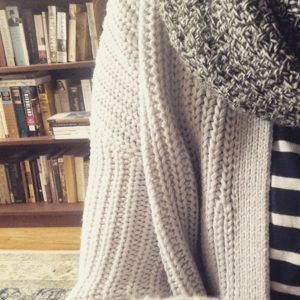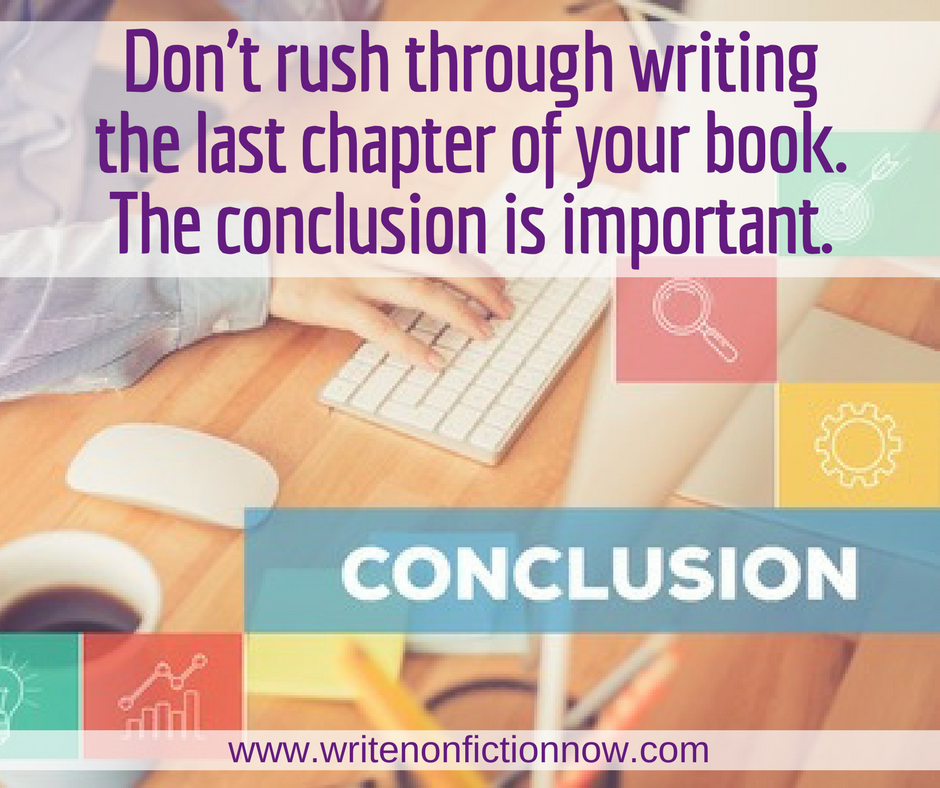I always say my authors “activate” in fall. They have spent their summers writing their books and then, inevitably, pop into my inbox in the first few weeks of September with freshly completed manuscripts. Their excitement to get the book off to their editor shows—but not always in a good way.
I always can tell when an author is just ready to be done writing. The final chapters get shorter and more similar in structure, and then the book ends in a conclusion that’s two pages long and sums up the book quickly before simply ending.
Conclusions often end up short and short-changed because writers feel they have nothing left to say. In a way, they are right: the bulk of the important ideas should be included in the main body of your book. But that doesn’t mean that the last chapter needs to be one that says nothing.
The conclusion can do a lot of interesting work to tie up the reading experience for the reader. It can help them think about the bigger implications of your story, the next steps they can take, or the lessons that they can learn from what they’ve read.
If you’re stuck on how to make your conclusion reach its potential, there is some good news: conclusions don’t need to be wildly innovative to make their mark. There are some basic formulas you can follow in creating a conclusion that wrap up your work in a meaningful way.
Conclusion #1: The “Where are They Now” Conclusion
In a ‘where are they now’ conclusion, the author talks about their or their subject’s current life after having undergone the journey discussed in the book. This type of conclusion works best with memoir or autobiography, but it can also work for biography or a kind of narrative involving multiple characters going through a concrete event.
If you use this type of conclusion, be careful not to just include a rote summary of what everyone’s doing; dive in to how the events in the book link up to your or the subject’s present-day experience.
Conclusion #2: The “Why Should We Care” Conclusion
This type of conclusion is the most common one I see, and that’s because it’s so effective. This kind of conclusion steps out from the close focus of the book to explore the bigger picture into which the book fits. In a journalistic story, it’s a chance to say how the stories in a book fit in to a larger trend and why that trend is important. In a history or other more discursive book, the conclusion is a place to explain how the topic discussed in the book illuminates new information and unveils new ways of looking at a particular subject.
The important thing to keep in mind with this kind of conclusion is that you want to avoid being repetitive, as you may have discussed the “so what” of your argument in your introduction or in scattered places throughout the book. If you find yourself in this position, my general advice is to examine the implications of the book more fully in the conclusion and change earlier discussion of those implications to be more succinct.
Conclusion #3: The “What Do We Do Now?” Conclusion
A “what do we do now” conclusion works well in how-to or advice books. If you are writing a book about getting involved in politics as a young person, for instance, you could write a conclusion that gives distilled real-world tips on how someone could get involved. If you are writing a book on how to do something that follows a standard process (say, writing nonfiction books) then the conclusion could be the final step in the process, or getting started again after going through the process once.
Conclusion #4: The “Artsy Cliffhanger” Conclusion
In memoirs, journalistic narratives, or true-crime books, there might not be a clear, solid ending to a narrative. The mystery hasn’t been solved; you (the memoirist) conquered your demons a little but not all the way; the international crisis in Africa you witnessed is still ongoing. In these cases, it could be interesting to take a more artistic approach and end the book with a story that shows there is not yet a resolution to the story.
This can be a moving ending, but take care to add in extra “so what” narration if it is not immediately clear why you are not adding in a more resolute conclusion to the book.
Conclusion #5: The Combo Method
As you might guess, sometimes just following one of these conclusion approaches won’t quite be enough for your book. In these cases, experiment with combining two or more approaches. A “where are they now” structure can be the story that makes up your “artsy cliffhanger” conclusion; a “why should we care” conclusion can take the form of a “what do we do now” ending. Above all, you should think about your readers: what would they want or need before ending the book? The conclusion is really for them.
As I’ve said before on this blog, there is no one-size-fits-all approach to writing any part of a book; what type of conclusion you have can vary by the kind of book you are writing and what you want to ultimately say. But what does matter is that you have one in the first place. Like I’ve said with introductions, take care to put together a good conclusion—you owe it to your readers to keep them engaged until the very end of the book.
About the Author
 C.K. Bush is a nonfiction editor and writer. She lives in New York City.
C.K. Bush is a nonfiction editor and writer. She lives in New York City.
Photo copyright: garagestock / 123RF Stock Photo

Rashmi Agrawal says
Yes I too believe that conclusion is as important as is the introduction. Conclusion can have some more related resources and sum up of everything but not the repetition.
Maria says
Thank you so much for such helpful guidance. I had already written my book – conclusion and all and, like so many, I thought I was done. I stepped away from it for a while and a little more research extended the thesis in a much more meaningful way. I then wrote the conclusion again then, I wondered had I gone too far and maybe gone into related areas that had only been mentioned throughout the other chapters. I did a Google search and ended up reading this article. It turned out that I had essentially used (unbeknowst to myself)
THE COMBO METHOD “where are they now” structure (or, in my case: where is the situation now), with a springling of “artsy cliffhanger”, a major coating of, “why should we care” followed by, “what do we do now” ending. And I considered my readers at this point quite considerably. This confirmed that I was instinctively on the right track and thanks to your article, I now how the tools to all my conclusions and customise the advice accordingly. The most important part of the advice of course, is to recognise that even when you think you have finished – that you maybe haven’t and, as I found in my own experience, by revisiting the conclusion – I had something much more profound to say, It was the bigger picture as you describe it and this seems to only come by taking a big step back from all that you have slaved over so lovingly and passionately – so that you as the writer actually get the significance of what you have just written. Thank you so much again.
Maria
Nina Amir says
So glad you found the post, Maria, and that it was hepful.
Mel Harness says
Writing my first book and needed help with a conclusion. Your suggestions were timeless!
Nina Amir says
Glad the post was timely for you!
Ethan LaFave says
I needed that so much to he;p me get a 100 A+.
THANK YOU!!!.
Laine says
Can a case study to validate the thesis be part of a conclusion? Or should it come before a conclusion, or after?
Steve Mannix says
Hello Nina,
Thank you for your many wise words to all who are passionate about words and putting them together correctly to help describe the vents of the story unfolding before the readers own eyes.
At the request of my eldest daughter, I have been writing a book (nonfiction) about events of my own life which saw me not only imprisoned at a particular time in my life (almost forty years ago now) but also put onto life support as a consequence of the new living environment I found myself in at that same time,and trying to survive in, on a day by day, hour by hour existence.
I found it very hard to write this book as in doing so I seemingly re-lived many unpleasant and hurtful events in my own mind.
Where to now though? It is a massive story and I do not want to put too much detail about it into an open letter that others may see and read.
I would dearly like to ask a couple of questions of you with regards to what to and where to from here?
Is it possible that you might respond to give me a guiding suggestion?
I would be very appreciative and would be open to share with you an absolutely massive story about an event in time which has never been told by anyone, to anyone. No media interview has ever been conducted and I am the only person out of the three people involved in this event (almost forty years ago) who is still alive and who can tell the story about what actually did happen.
That is why my daughter asked me to document it all whilst i was still alive. I am currently sixty one years old. (2019)
Infamous these events and this story are; definitely NOT ‘famous’ but historical and TRUE CRIME none the less.
I was one who the system decided to make a public example of, … and continues to do so all of these years later.
It was a matter of property and NOT one of people. I did not harm at any time, man, Woman or child, nor did I break into anybody’s private home, corner shop, department store or harm the family cat or dog.
None the less, a whipping boy I was made, and I have been constantly lashed by the opinions of others who some were not even alive at the time, yet make judgement s of events they could not know about; .. simply because I have never discussed them with anybody. They look at the headline only, and not the story behind the headlines.
It is indeed a fascinating story.
I await your reply.
With respect
Stay well, God Bless
Steve Mannix
Australia.
Nina Amir says
Why not contact me for a free 15-minutes session? Go here: https://ninaamir.as.me/15-min-strategy-session
Nina Amir says
I would do it long before a conclusion.